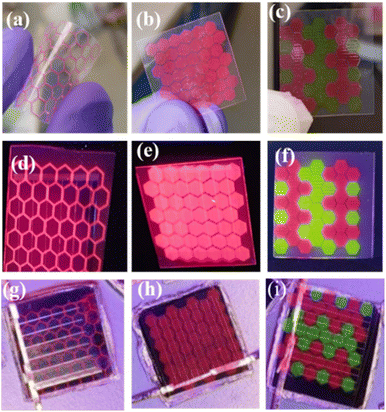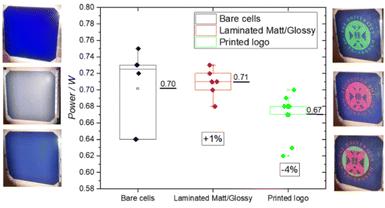 Open Access Article
Open Access ArticleCreative Commons Attribution 3.0 Unported Licence
Visually attractive and efficient photovoltaics through luminescent downshifting†
Neena Kurian
Kalluvettukuzhy
a,
Michal Robert
Maciejczyk
a,
Ian
Underwood
b and
Neil
Robertson
 *a
*a
aEaStCHEM School of Chemistry, University of Edinburgh, Kings Buildings, Edinburgh, EH9 3FJ, UK. E-mail: neil.robertson@ed.ac.uk
bScottish Microelectronics Centre, University of Edinburgh, Kings Buildings, Edinburgh, EH9 3FJ, UK. E-mail: i.underwood@ed.ac.uk
First published on 26th May 2023
Abstract
Aesthetics of solar cells have become more important in recent years and the academic, industry and PV market trends include the implementation of PV modules free of aesthetic constraints. To date, this has been accompanied by negative consequences on cost and performance. We highlight, and further develop, a technical approach toward fabricating brightly coloured, patterned, visually appealing solar cells and panels while not compromising the efficiency, by exploiting the neglected potential of luminescence down shifting (LDS) materials. Only a few literature reports have previously demonstrated LDS in providing aesthetic appeal to different PV technology. We have built upon this to demonstrate a cost-effective, stand-alone film that can be used to develop customizable coloured/printed/graphically designed solar cells while maintaining their efficiency. A key advantage of the current method is that the film can be easily removable or replaceable, when the coloured structures have aged or a different appearance is desired, thus holding great potential for future product-integrated photovoltaics, solar cells with artistic designs, communication, company logos, advertisements and automotive applications.
Introduction
The world's primary energy sources are currently non-renewable; approximately 80% of global energy consumption comes from fossil fuels. Among the greatest challenges facing society today is the depletion of non-renewable energy resources and the associated environmental consequences of emissions.1,2 Looking toward a sustainable global economy and a future beyond fossil fuels has pushed researchers to explore new energy conversion and storage technologies. Harnessing solar energy to produce electricity, photovoltaic (PV) technology, has already proven to be economical, scalable, clean and a significant component of an overall solution to the global energy crisis. Tremendous advancements in the solar PV industry, in terms of installations, cost reductions and technological advancements, have led to an approximate doubling of installed capacity every two years over recent decades.3–5 However, the majority of PV panels available in the market are either black or dark blue in colour which can be a hurdle in the journey towards widespread deployment of solar panels, especially in residential, domestic and consumer applications where aesthetic considerations are more important.6,7 Architects and designers are obliged to take into account visual appearance alongside energy, economic and environmental factors.8–10 This has pushed the demand for new technologies that are able to implement visually attractive customized PV panels with colours, prints or patterns according to customer preference. This can help the wide adoption of solar modules as an integral part of the building, such that building facades can harvest energy, and contribute toward addressing the current energy crisis.11–14 To date, various technologies have been adopted to produce coloured PV panels, including – fluorescent dyes (added to the internal encapsulation layer),15 colour-reflecting films,16 semi-transparent cells,14 organic photovoltaics,17 dye-sensitised solar cells,18 and luminescence down-shifting materials.19 Most of the transparent, or coloured, solar panels in pilot studies or approaching commercial maturity use anti-reflective coatings with colours given by controlling the reflection,20 and semi-transparent cells.14,21 The major challenges faced by coloured photovoltaic panels are high production and maintenance costs, complex construction, limited colour purity (saturation), and a significant drop in energy conversion efficiency.21,22 Even though there is an unmet demand for coloured PV panels in the market, the poorer efficiency and higher cost present a barrier to their effective adoption to achieve commercial maturity.The utilization of a forty-year-old technology, luminescence down shifting (LDS), could offer an elegant solution to this problem. LDS is an optical approach for converting higher-energy UV photons to lower-energy visible photons (Fig. 1).23–26 LDS technology has been proposed for use in solar cells to increase the spectral response at higher energy regions of the solar spectrum and thereby increase the power conversion efficiency of PV cells. Proof of concept has been demonstrated in numerous studies.23 LDS technology has been studied as a method to improve the spectral response at high energy regions in all different types of PV technologies,27 including Si (single crystalline28 and multi-crystalline29), organic photovoltaics,30 dye sensitized solar cells,31 polymer solar cells,32 perovskite solar cells19 and thin film solar cells (CdS,33 CdTe,34 CIGS35etc.). LDS layers attached to the solar cell absorbs light from the electromagnetic radiation falling on it, depending on the absorption wavelength of the dye used.23 After absorbing the light, the dye will emit photons at a longer wavelength. A major fraction of the emitted light will be absorbed by the PV active material either directly or following reflection at the LDS: air interface. A smaller fraction of luminescence will exit the device through the top escape cone and through the sides of the LDS layer.23 Thus, the LDS materials impart colour to the PV devices via the luminescence escape from the devices that reaches the human eye. By properly tuning the optical properties of an LDS film, it is possible to absorb UV radiation and convert it into radiation with a wavelength that spectrally matches the maximum of the external quantum efficiency (EQE) of the device.37 It has also been shown that the use of LDS layers increases the lifetime of PV modules by filtering UV radiation and will facilitate improved stability in perovskite solar cells38 and organic photovoltaics (OPV).39 Several studies have also investigated the use of LDS materials as an alternative to UV filters in PV devices because the use of LDS layers doesn't detrimentally affect solar cell performance.38–41 This approach will be most useful in the regions of earth were UV light place a major role in the degradation of PV devices. Certain optical parameters of luminescent molecules, such as broadband absorption (300–500 nm), high molar absorptivity, large Stokes shift, close to unity photo-luminescence quantum efficiency, high photostability, low cost of production and high mass absorptivity (1 g−1 cm−1) should be considered when selecting a LDS material for PV cells and their practical implementations.24–26 To date, various types of luminescent materials including inorganic phosphors,42 quantum dots,43 organic dyes44 and organolanthanide complexes45 have shown promise as LDS layers in PV cells. Each of these material types has advantages and disadvantages.25 A comparison of solar cell performance with and without LDS layers based on several studies in different PV technologies is given in Table S1.† LDS was first proposed as a method to improve solar cell efficiency in the early 1980s.46 Since then however, the improvements in cell efficiency and the huge decline in the PV module prices have undermined the motivation for developing LDS materials as a method to improve solar cell efficiency. Specifically, the efficiency increase with an additional LDS layer in PV cells (typically 0.2–4.0% increase)23–31 is not high enough to compensate the extra cost associated with its introduction. This includes both additional material costs and costs of production associated with an additional layer within the well-optimized solar manufacturing process.3,5 Thus, the traditional motivation for developing such LDS materials – increased power-conversion efficiency – is difficult to justify in the current scenario and it is highly unlikely to ever achieve a significant role in the commercial PV market. Herein we wish to highlight the much neglected potential of LDS to merge the above two drivers, by achieving both good efficiency and an attractive appearance, that together could provide commercial appeal (Fig. 1).
The current PV market trends and needs offer a well-suited opportunity for the renaissance of LDS technology; the implementation of LDS layers in solar cells to impart colour in a very efficient way without compromising the performance of PV modules. The advantage of this approach is that the electrical output of the devices can be retained, or even improved in favourable cases (Table S1†). This kind of visually attractive coloured solar panel can drive market penetration in segments where the limited aesthetics of solar modules is currently a barrier to wide market uptake. This includes applications in building-integrated PV (BIPV), consumer electronics, wearables/clothing, electric vehicles, custom modules, brandings, signage, and camouflage.11–13 The opportunity to target luminescent layers towards optimising visual appearance rather than simply aiming for modest efficiency changes is elaborated below. We first highlight a few prior studies in which enhanced visual appeal has featured as part of the LDS study. Thereafter, we build upon these prior approaches to propose and demonstrate an efficient method to utilise LDS materials as a stand-alone component to improve the aesthetics of PV modules in a convenient and flexible way, without compromising the efficiency. Finally, we discuss the challenges and future opportunities in this underdeveloped field.
Discussion
Richards and co-workers demonstrated the potential of LDS materials for designs with different colour combinations, on Si and cadmium telluride (CdTe) solar modules while maintaining efficiency.36,47,48 In these studies, the authors used an ethylene vinyl acetate (EVA) matrix to create the coloured LDS layers, which were then laminated on the top of commercially available mini PV modules (Fig. 2a–c). PV devices with designed images were fabricated by cutting simple stripes and squares from differently coloured EVA sheets containing LDS materials and manually assembling these on the CdTe/c-Si mini-modules before lamination. The clarity of the different colours was thereby not skewed during the lamination step, showing its potential for aesthetical and/or functional colouration of PV modules (Fig. 2d–f), albeit with a procedure that would be difficult to implement in commercial systems. The graphically designed CdTe mini-module showed a current enhancement of 0.4 mA cm−2. According to the authors, this study shows that high-quality functional colouration can be achieved for the commercially established, robust and efficient first- and second-generation PV technologies.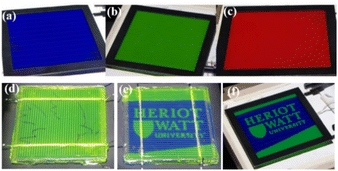 | ||
| Fig. 2 Coloured and printed PV modules developed by Richards and co-workers (a–c) CdTe mini-modules encapsulated with respectively blue, green and red coloured EVA/FEP layers (Reprinted with permission from ref. 46. Copyright, 2014, IEEE). (d) Dove of peace artistic design on CdTe module, (e, f) HWU logo on C–Si and CdTe modules, respectively, the images are captured under solar simulator illumination (Reprinted with permission from ref. 48, Copyright, 2015, IEEE). | ||
Later, the same group exploited various luminogen dye-based LDS materials to impart colour in a range of PV technologies like CdTe, copper–indium–gallium–(di)selenide (CIGS) and multi-crystalline silicon (mc-Si) solar cells.49 The devices were fabricated by directly depositing the LDS materials on PMMA/EVA polymer layers on top of different PV modules (Fig. 3), however only uniform colours were used, and the focus was on efficiency improvement, rather than appearance.
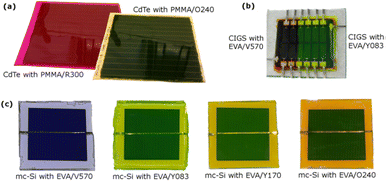 | ||
| Fig. 3 Examples showing the effectiveness of LDS method to develop single-coloured solar cells of different PV technology (a) CdTe, (b) CIGS and (c) mc-Si. (Reprinted with permission from ref. 49. Copyright, 2014, John Wiley & Sons Ltd.). | ||
Later they exploited inkjet printing techniques to achieve flexibility in terms of colour and shapes of solar panels.19 For this study, metal halide perovskites were chosen as the absorbing material and the perovskite solar cells (PSC) were partially fabricated via inkjet printing. Different Lumogen-F dyes having emissions in the visible wavelength range were used in the development of coloured LDS layers. A PMMA-based ink was used for the dyes, and the dye concentration was adjusted in such a way as to obtain maximum photoluminescence quantum yield (PLQY). The perovskite PV cells with different Lumogen dyes deposited via inkjet printing showed different colours (Fig. 4a and b, further details about the preparation of coloured layers for these examples are given in ESI†). The performance of PSCs with LDS layers showed a negligible drop with an increasing number of LDS layers, although the power conversion efficiency of PSC coated with red dyes decreased from 11.5% to 9.4% due to the inevitable absorption of the dye (Fig. 4c–e). These studies demonstrated that great flexibility can be achieved in terms of the colour and shape of perovskite solar cells by inkjet printing LDS layers. The major drawback limiting the technological application of this method is the use of glass substrates for printing both solar cells and LDS layers, and replaceability of the coloured layers would require the replacement of whole PV cells.
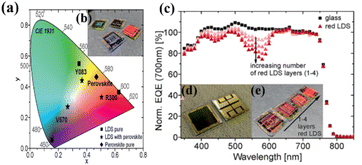 | ||
| Fig. 4 (a) CIE-diagram with the colour perception of different LDS and perovskite layers under sunlight, (b) inkjet-printed LDS layers on glass slides stacked on inkjet-printed PSC under solar simulator (c) EQE (normalized to 700 nm) of a PSC coated with up to four red LDS layers. (d) Photograph of inkjet-printed PSC without LDS layer (e) photograph of inkjet-printed LDS layers with different thicknesses placed on top of PSCs, illuminated under solar simulator (Reprinted with permission from ACS Appl. Energy Mater., ref. 19. Copyright, 2019, American Chemical Society). | ||
Building on these prior reports, our studies have introduced a viable approach toward fabricating brightly coloured, graphically designed, and aesthetically pleasing customizable solar cells in a practical system without compromising efficiency. We have developed a stand-alone film that can be added to impart colour to solar cells without affecting their production cost or maintenance. The coloured layers can be retrospectively added to the desired solar cells, which gives high flexibility in terms of colour, design patterns, shape, and applications. Furthermore, the LDS films can, in principle, be removed and replaced many times during the lifetime of a PV module. The current approach involves facile inkjet printing of LDS layers on a polymer substrate (PET/ETFE). The coloured or graphically designed film can then be added onto a solar cell during the standard lamination procedure or can also be added as a post-manufacturing process making it more customizable. The added design may be used to increase the aesthetic value of the item, better match with the total design of the product by ‘hiding’ solar cells behind this coating, or be used for marketing e.g. showing the company logo, name or other information. The applications can be extended to consumer electronics like portable chargers, power banks, and covers for phones/tablets and toys. Further development of the technology may find application in the automotive sector such as in solar-assisted electric vehicles.
In our methodology, commercially available Lumogen-F dyes as LDS materials are combined with PMMA for inkjet printing. Examples of the printed graphics on film under indoor illumination (Fig. 5a–c) demonstrate the possibility of different patterns, opening the door for versatile colours and vivid designs. The same film shows luminescent properties when irradiated with UV (365 nm) light (Fig. 5d–f), so by acting as LDS material, they will transfer absorbed energy to the PV active material and contribute to the device performance. This will give an efficiency increase in favourable cases or at least a minimal efficiency penalty in less-favourable cases. Once the coloured ETFE sheets are laminated over commercially available small PV cells, the outcome is effective in terms of enhanced appearance of the solar cells (Fig. 5g–i). The inkjet printing techniques give the freedom to develop versatile, bespoke design opportunities for coloured or patterned solar cells with LDS materials (Fig. 5, 6 and S2–S7†).
 | ||
| Fig. 6 Solar cells decorated with vivid coloured printed logos (a–c) and versatile design opportunities (d and e) with LDS materials (12.5 cm × 12.5 cm Sun power solar cells). | ||
This methodology is further demonstrated in making printed logos and complex graphical designs involving the use of multiple colours. As proof of concept, we studied the application of coloured LDS layers in commercially available Si solar cells (12.5 cm × 12.5 cm Sun power solar cells). Fig. 6a–c shows these solar cells topped with the “University of Edinburgh” logo printed on ETFE foil in different colours, opening the door to consumer preferences and offering a new avenue to displays in brandings, signage and camouflage. Fig. 6d and e shows the feasibility for complex designs allowing PV art designs for different applications. We measured the power conversion efficiency of solar cells laminated with our graphically designed ETFE foils containing LDS materials and bare cells. The results confirmed that the LDS-enhanced solar cells showed comparable power conversion efficiency to that of bare cells and the lamination with ETFE foil had a negligible effect on the performance (Fig. 7 and S5†). This clearly shows that our designed LDS layers improve the aesthetic appearance of solar cells without detrimental effect on solar cell efficiency. Importantly, the reported approach allows ease of implementation with currently existing solar cell technologies with a small cost of up to around 1 USD m−2 (ESI†). The developed technology can be used for improving the aesthetic appearance of all the different types of PV technologies, including organic photovoltaics, dye sensitized solar cells, polymer solar cells, perovskite solar cells and thin film solar cells (CdS, CdTe, CIGS etc.).
Conclusion and future perspective
Our studies present a novel approach for fabricating brightly coloured multi-functional solar cells that can offer aesthetic appeal, crucially without significant effects on efficiency or interfering with highly-optimised manufacturing processes. We have demonstrated customisable PV cells with colours or designs using a post-manufacturing process (Fig. 8), such that films could also be removed and replaced when desired. Inkjet printing is a scalable and well-established technology that is very much affordable. A wide variety of colourful luminogens are commercially available and low-cost thereby giving freedom to the consumers according to their designs. Beyond our demonstrated results on individual cells, an analogous approach of post-manufacture modification of full-size modules can in principle also be readily achieved with our stand-alone inkjet-printed films. This affords the rendering of the fine design onto PV modules making this technology commercially feasible at large scale. These studies demonstrate that LDS technology, which has not previously secured a viable market based on efficiency enhancement alone, offers a novel and straightforward approach to cost-effective appearance enhancement without significant efficiency detriment.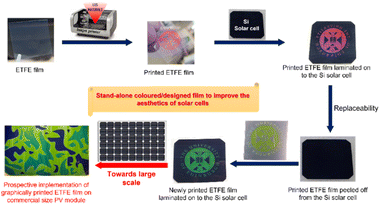 | ||
| Fig. 8 Our method for developing stand-alone products for printed/designed solar cells and representative image showing prospective implementation of this technology in PV modules in large scale. | ||
This method provides great potential to utilize unused space for future advertisements, communication purposes, company logos, automotive PV, product integrated PV and BIPV, opening new horizons that cannot be addressed by current mature PV technologies.
Conflicts of interest
There are no conflicts to declare.Acknowledgements
We thank EPSRC and CAMREG-Centre for Advanced Materials for Renewable Energy Generation (KP5-Project), University of Edinburgh for the financial support. MRM and NKK thank the Innovation Programme H2020-MSCA-IF-2014-659237 and H2020-MSCA-IF-2020-101025621, respectively for financial support.Notes and references
- O. B. Awodumi and A. O. Adewuyi, Energy Strategy Rev., 2020, 27, 100434 CrossRef.
- L. D. Meinert, G. R. Robinson and N. T. Nassar, Resources, 2016, 5, 14 CrossRef.
- N. M. Haegel, R. Margolis, T. Buonassisi, D. Feldman, A. Froitzheim, R. Garabedian, M. Green, S. Glunz, H.-M. Henning, B. Holder, I. Kaizuka, B. Kroposki, K. Matsubara, S. Niki, K. Sakurai, R. A. Schindler, W. Tumas, E. R. Weber, G. Wilson, M. Woodhouse and S. Kurtz, Science, 2017, 356, 141–143 CrossRef CAS PubMed.
- G. C. Righini and F. Enrichi, Solar cells' evolution and perspectives: a short review, ed. F. Enrichi and G. C. Righini, Solar cells and light management, Elsevier, 2020, pp. 1–32 Search PubMed.
- C. Gao, D. Du, D. Ding, F. Qiao and W. Shen, J. Mater. Chem. A, 2022, 10, 10811–10828 RSC.
- K.-T. Lee, L. J. Guo and H. J. Park, Molecules, 2016, 21, 475 CrossRef PubMed.
- L.-M. Yu, J.-X. Man, T. Chen, D. Luo, J. Wang, H. Yang, Y.-B. Zhao, H. Wang, Y. Yang and Z.-H. Lu, Nano Energy, 2021, 85, 105937 CrossRef CAS.
- Q. Bao, T. Honda, S. El Ferik, M. M. Shaukat and M. C. Yang, Renewable Energy, 2017, 113, 1569–1579 CrossRef.
- B. Lee, L. Lahann, Y. Li and S. R. Forrest, Sustainable Energy Fuels, 2020, 4, 5765–5772 RSC.
- R. J. Yang and P. X. W. Zou, Int. J. Constr. Manag., 2016, 16, 39–53 Search PubMed.
- Y. Dai and Y. Bai, Energies, 2021, 14, 178 CrossRef CAS.
- H. Wang, J. Li, H. A. Dewi, N. Mathews, S. Mhaisalkar and A. Bruno, J. Phys. Chem. Lett., 2021, 12, 1321–1329 CrossRef CAS PubMed.
- G. Apostolou and A. H. M. E. Reinders, Energy Technol., 2014, 2, 229–242 CrossRef.
- C. J. Traverse, R. Pandey, M. C. Barr and R. R. Lunt, Nat. Energy, 2017, 2, 849–860 CrossRef.
- D. A. Hardy, S. C. Roaf and B. S. Richards, Int. J. Sustain. Dev. Plan., 2015, 10, 863–879 CrossRef.
- C. Ji, Z. Zhang, T. Masuda, Y. Kudo and L. J. Guo, Nanoscale Horiz., 2019, 4, 874–880 RSC.
- X. Li, R. Xia, K. Yan, J. Ren, H.-L. Yip, C.-Z. Li and H. Chen, ACS Energy Lett., 2020, 5, 3115–3123 CrossRef CAS.
- Y. Ren, D. Sun, Y. Cao, H. N. Tsao, Y. Yuan, S. M. Zakeeruddin, P. Wang and M. Grätzel, J. Am. Chem. Soc., 2018, 140, 2405–2408 CrossRef CAS PubMed.
- S. Schlisske, F. Mathies, D. Busko, N. Strobel, T. Rödlmeier, B. S. Richards, U. Lemmer, U. W. Paetzold, G. Hernandez-Sosa and E. Klampaftis, ACS Appl. Energy Mater., 2019, 2, 764–769 CrossRef CAS.
- K. Ding, X. Zhang, L. Ning, Z. Shao, P. Xiao, A. Ho-Baillie, X. Zhang and J. Jie, Nano Energy, 2018, 46, 257–265 CrossRef CAS.
- K. Lee, N. Kim, K. Kim, H.-D. Um, W. Jin, D. Choi, J. Park, K. J. Park, S. Lee and K. Seo, Joule, 2020, 4, 235–246 CrossRef CAS.
- H. Lee and H.-J. Song, WIREs Energy Environ., 2021, 10, e403 Search PubMed.
- E. Klampaftis, D. Ross, K. R. McIntosh and B. S. Richards, Sol. Energy Mater. Sol. Cells, 2009, 93, 1182–1194 CrossRef CAS.
- D. Alonso-Álvarez, D. Ross and B. S. Richards, in 2012 38th IEEE Photovoltaic Specialists Conference, 2012, pp. 9–14 Search PubMed.
- R. A. S. Ferreira, S. F. H. Correia, A. Monguzzi, X. Liu and F. Meinardi, Mater. Today, 2020, 33, 105–121 CrossRef.
- X. Huang, S. Han, W. Huang and X. Liu, Chem. Soc. Rev., 2013, 42, 173–201 RSC.
- B. McKenna and R. C. Evans, Adv. Mater., 2017, 29, 1606491 CrossRef PubMed.
- G. Shao, C. Lou and D. Xiao, J. Lumin., 2015, 157, 344–348 CrossRef CAS.
- W.-B. Hung and T.-M. Chen, Sol. Energy Mater. Sol. Cells, 2015, 133, 39–47 CrossRef CAS.
- F. Wang, Z. Chen, L. Xiao, B. Qu and Q. Gong, Opt. Express, 2011, 19, A361–A368 CrossRef PubMed.
- Z. Hosseini, W.-K. Huang, C.-M. Tsai, T.-M. Chen, N. Taghavinia and E. W.-G. Diau, ACS Appl. Mater. Interfaces, 2013, 5, 5397–5402 CrossRef CAS PubMed.
- G.-F. Ma, H.-J. Xie, P.-P. Cheng, Y.-Q. Li and J.-X. Tang, Appl. Phys. Lett., 2013, 103, 43302 CrossRef.
- E. Regalado-Pérez, N. R. Mathews and X. Mathew, Sol. Energy, 2020, 199, 82–91 CrossRef.
- H. Ahmed, S. J. McCormack and J. Doran, Sol. Energy, 2017, 141, 242–248 CrossRef CAS.
- A. Gavriluta, T. Fix, A. Nonat, A. Slaoui, J.-F. Guillemoles and L. J. Charbonnière, J. Mater. Chem. A, 2017, 5, 14031–14040 RSC.
- E. Klampaftis, D. Ross and B. S. Richards, in 2014 IEEE 40th Photovoltaic Specialist Conference (PVSC), 2014, pp. 25–29 Search PubMed.
- Y. Jestin, S. Chandra, B. Cass, H. Ahmed and S. J. McCormack, Down-shifing of the incident light for photovoltaic applications, ed. T. M. Letcher, Comprehensive renewable energy, Elsevier, 2022, 2nd edn, pp. 534–560 Search PubMed.
- H. S. Anizelli, V. Stoichkov, R. V. Fernandes, J. L. Duarte, E. Laureto, J. Kettle, I. Visoly-Fisher and E. A. Katz, Org. Electron., 2017, 49, 129–134 CrossRef CAS.
- R. V. Fernandes, N. Bristow, V. Stoichkov, H. S. Anizelli, J. L. Duarte, E. Laureto and J. Kettle, J. Phys. D: Appl. Phys., 2017, 50, 25103 CrossRef.
- H. C. Weerasinghe, Y. Dkhissi, A. D. Scully, R. A. Caruso and Y.-B. Cheng, Nano Energy, 2015, 18, 118–125 CrossRef CAS.
- J. Kettle, N. Bristow, D. T. Gethin, Z. Tehrani, O. Moudam, B. Li, E. A. Katz, G. A. dos Reis Benatto and F. C. Krebs, Sol. Energy Mater. Sol. Cells, 2016, 144, 481–487 CrossRef CAS.
- N. U. Rahman, W. U. Khan, S. Khan, X. Chen, J. Khan, J. Zhao, Z. Yang, M. Wu and Z. Chi, J. Mater. Chem. A, 2019, 7, 6467–6474 RSC.
- S.-W. Baek, J.-H. Shim and J.-G. Park, Phys. Chem. Chem. Phys., 2014, 16, 18205–18210 RSC.
- A. Pardo Perdomo, R. Vignoto Fernandes, N. J. Artico Cordeiro, F. Franchello, M. A. Toledo da Silva, J. Leonil Duarte and E. Laureto, J. Appl. Phys., 2020, 128, 35502 CrossRef CAS.
- D. Yang, H. Liang, Y. Liu, M. Hou, L. Kan, Y. Yang and Z. Zang, Dalton Trans., 2020, 49, 4725–4731 RSC.
- H. J. Hovel, R. T. Hodgson and J. M. Woodall, Sol. Energy Mater., 1979, 2, 19–29 CrossRef CAS.
- D. Ross, D. Alonso-Álvarez, E. Klampaftis, J. Fritsche, M. Bauer, M. G. Debije, R. M. Fifield and B. S. Richards, IEEE J. Photovolt., 2014, 4, 457–464 Search PubMed.
- E. Klampaftis, D. Ross, G. Kocher-Oberlehner and B. S. Richards, IEEE J. Photovolt., 2015, 5, 584–590 Search PubMed.
- D. Alonso-Álvarez, D. Ross, E. Klampaftis, K. R. McIntosh, S. Jia, P. Storiz, T. Stolz and B. S. Richards, Prog. Photovolt. Res. Appl., 2015, 23, 479–497 CrossRef.
Footnote |
| † Electronic supplementary information (ESI) available: Details of inkjet printing, ink formulation and cost analysis. See DOI: https://doi.org/10.1039/d3ta00734k |
| This journal is © The Royal Society of Chemistry 2023 |


